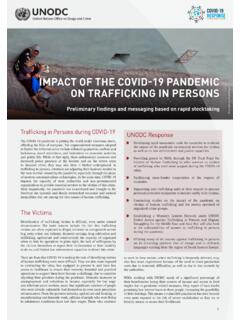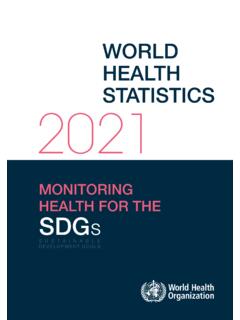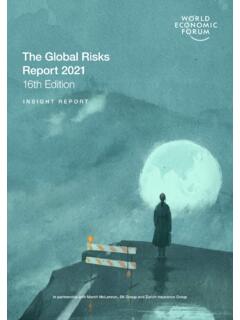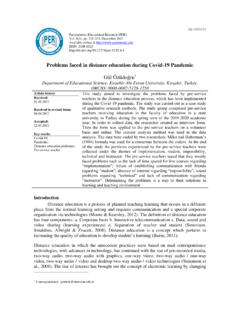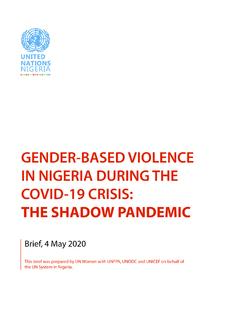Transcription of Impacts of COVID-19 on food security and nutrition ...
1 Committee on World food security High Level Panel of Experts on food security and nutrition Rome, September 2020 Impacts of COVID-19 on food security and nutrition : developing effective policy responses to address the hunger and malnutrition pandemic HLPE issues paper Cover photograph: FAO, 2020 HLPE Steering Committee Chairperson: Martin Cole Vice-Chairperson: Bernard Lehmann Steering Committee members: Barbara Burlingame, Jennifer Clapp, Mahmoud El Solh, M ria Kadle kov , Li Xiande, Bancy Mbura Mati, William Moseley, Nitya Rao, Thomas Rosswall, Daniel Sarpong, Kamil Shideed, Jos Mar a Sumpsi Vi as, Shakuntala Thilsted Experts participate in the work of the HLPE in their individual capacities, not as representatives of their respective governments, institutions or organizations. HLPE Joint Steering Committee / Secretariat drafting team Team Leader: Jennifer Clapp (Steering Committee) Team members: William Moseley (Steering Committee), Paola Termine (Secretariat) HLPE Secretariat Coordinator: variste Nicol tis Programme consultant: Paola Termine Loaned expert: Qin Yongjun Administrative support: Massimo Giorgi Viale delle Terme di Caracalla 00153 Rome, Italy Tel: +39 06 570 52762 : This report by the High Level Panel of Experts on food security and nutrition (HLPE) has been approved by the HLPE Steering Committee.
2 The views expressed do not necessarily reflect the official views of the Committee on World food security , of its members, participants, or of the Secretariat. The mention of specific companies or products of manufacturers, whether or not these have been patented, does not imply that these have been endorsed or recommended by the HLPE in preference to others of a similar nature that are not mentioned. This report is made publicly available and its reproduction and dissemination is encouraged. Non-commercial uses will be authorized free of charge, upon request. Reproduction for resale or other commercial purposes, including educational purposes, may incur fees. Applications for permission to reproduce or disseminate this report should be addressed by e-mail to with copy to Recommended citation: HLPE. 2020. Impacts of COVID-19 on food security and nutrition : developing effective policy responses to address the hunger and malnutrition pandemic .
3 Rome. Page 1 of 22 Impacts of COVID-19 on food security and nutrition : developing effective policy responses to address the hunger and malnutrition pandemic INTRODUCTION The COVID-19 pandemic that has spread rapidly and extensively around the world since late 2019 has had profound implications for food security and nutrition . The unfolding crisis has affected food systems1 and threatened people s access to food via multiple dynamics. We have witnessed not only a major disruption to food supply chains in the wake of lockdowns triggered by the global health crisis, but also a major global economic slowdown. These crises have resulted in lower incomes and higher prices of some foods, putting food out of reach for many, and undermining the right to food and stalling efforts to meet Sustainable Development Goal (SDG) 2: Zero hunger. The situation is fluid and dynamic, characterized by a high degree of uncertainty.
4 According to the World Health Organization, the worst effects are yet to come (Ghebreyesus, 2020; Khorsandi, 2020). Most health analysts predict that this virus will continue to circulate for a least one or two more years (Scudellari, 2020). The food security and nutrition risks of these dynamics are serious. Already, before the outbreak of the pandemic , according to the latest State of food security and nutrition report (FAO et al., 2020), some two billion people faced food insecurity at the moderate or severe level. Since 2014, these numbers have been climbing, rising by 60 million over five years. The COVID-19 pandemic is undermining efforts to achieve SDG 2. The complex dynamics triggered by the lockdowns intended to contain the disease are creating conditions for a major disruption to food systems, giving rise to a dramatic increase in hunger. The most recent estimates indicate that between 83 and 132 million additional people (FAO et al.)
5 , 2020) including 38-80 million people in low-income countries that rely on food imports (Torero, 2020) will experience food insecurity as a direct result of the pandemic . At least 25 countries, including Lebanon, Yemen and South Sudan, are at risk of significant food security deterioration because of the secondary socio-economic Impacts of the pandemic (FAO and WFP, 2020). In Latin America, the number of people requiring food assistance has almost tripled in 2020 (UN, 2020a). food productivity could also be affected in the future, especially if the virus is not contained and the lockdown measures continue. The purpose of this issues paper, requested by the Chairperson of the Committee on World food security (CFS), is to provide insights in addressing the food and nutrition security implications of the COVID-19 pandemic and to inform the preparations for the 2021 UN food Systems Summit.
6 In March 2020, the High-Level Panel of Experts on food security and nutrition (HLPE) published an issues paper on the impact of COVID-19 on food security and nutrition (HLPE, 2020a), and in June 2020, its 15th report (HLPE 2020b) provided an update on the ways in which food security and nutrition are affected by the pandemic . In the months following the publication of these reports, we have seen many of the concerns outlined in these reports materialize and we have learned more about the complex ways in which the pandemic has affected food security and nutrition . This issues paper updates and extends the HLPE s earlier analysis by providing a more comprehensive and in-depth review of the main trends affecting food systems that have resulted from COVID-19 and associated lockdown. It also expands the analysis of the pandemic s implications for the various dimensions of food security (HLPE, 2020b).
7 1 food systems include all the activities that relate to the production, processing, distribution, preparation and consumption of food . The three constituent elements of food systems are: food supply chains, food environments and consumer behavior (HLPE 12, 2017). In this document, the term agriculture is used in its broad connotation, which includes farming, animal production, forestry, fisheries and aquaculture, and related activities. Page 2 of 22 Impacts of COVID-19 on food security and nutrition : developing effective policy responses to address the hunger and malnutrition pandemic It is vital that the global community continue to monitor the situation closely, respond in necessary ways to avert the worst outcomes with respect to food security and nutrition , and carefully consider how to build more resilient food systems and ensure the right to food , in order to achieve SDG 2.
8 The recommendations starting at page 10 of this document seek to provide guidance for how to proceed along these lines. 1. HOW COVID-19 IS AFFECTING food security AND nutrition COVID-19 is a respiratory illness and there is no evidence that food itself is a vector of its transmission (ICMSF, 2020). However, the virus, and measures to contain its spread, have had profound implications for food security , nutrition and food systems. At the same time, malnutrition (including obesity) increases vulnerability to COVID-19 . Initial and ongoing uncertainty surrounding the nature of the spread of COVID-19 led to the implementation of strict lockdown and physical distancing policies in a number of countries. These measures caused a serious slowdown in economic activity and disrupted supply chains, unleashing new dynamics with cascading effects on food systems and people s food security and nutrition .
9 Below we outline these dynamics. We then highlight how these trends are affecting the six dimensions of food security proposed by the HLPE in its 15th report availability, access, utilization, stability, agency and sustainability which are essential for ensuring the right to food (HLPE, 2020b). a. Dynamics unleashed by the pandemic are affecting food security and nutrition A number of overlapping and reinforcing dynamics have emerged that are affecting food systems and food security and nutrition thus far, including: disruptions to food supply chains; loss of income and livelihoods; a widening of inequality; disruptions to social protection programmes; altered food environments; and uneven food prices in localized contexts (see, Klassen and Murphy, 2020; Clapp and Moseley, 2020; Laborde et al., 2020). Moreover, given the high degree of uncertainty around the virus and its evolution, there may be future threats to food security and nutrition , including the potential for lower food productivity and production, depending on the severity and duration of the pandemic and measures to contain it.
10 Below is a brief overview of these dynamics, which are also depicted in Figure 1. These effects have unfolded in different ways as the pandemic has unfolded over its initial, medium, and potential longer-term Impacts , as summarized in Figure 2. Page 3 of 22 Impacts of COVID-19 on food security and nutrition : developing effective policy responses to address the hunger and malnutrition pandemic FIGURE 1 | The dynamics of COVID-19 that threaten food security and nutrition COVID-19 Lockdown policiesGlobal economic recessionDisrupted supply chainsUneven food price effectsDeepening inequalitiesAltered food environmentsDisrupted social protectionChanges in productionIncreased povertyandfood insecurity Source: Authors. Supply chain disruptions There have been major disruptions to food supply chains in the wake of lockdown measures, which have affected the availability, pricing, and quality of food (Barrett, 2020).










